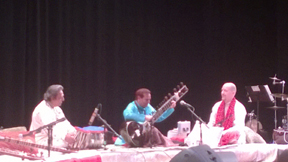 The musical strains of Pandit Habib Khan’s sitar accompanied by the percussion sounds of Pandit Swapan Chowdhury’s tabla dominated the afternoon performance at Cubberly Theater, Palo Alto last Sunday. The duo brought to life the nuances of raag Kirwani, before the stage was opened up to Khan Sahab’s shaagirds (students) of the Saraswati Temple and Gurukul showcasing their talents. Both parts of the performance had their unique offerings which entertained and enthralled the audience.
The musical strains of Pandit Habib Khan’s sitar accompanied by the percussion sounds of Pandit Swapan Chowdhury’s tabla dominated the afternoon performance at Cubberly Theater, Palo Alto last Sunday. The duo brought to life the nuances of raag Kirwani, before the stage was opened up to Khan Sahab’s shaagirds (students) of the Saraswati Temple and Gurukul showcasing their talents. Both parts of the performance had their unique offerings which entertained and enthralled the audience.
The sitar seems like an extension of Khan Sahab’s persona in the way he unites with his muse and delivers stellar renditions. Raag Kirwani is said to be most suited for instrumental playing, and is one of the lesser played ones in public. Khan Sahab took his time to introduce the audience to the color, nature and beauty of this raag and set the mood with his dexterous use of the notes in the opening aalap.
The jod aalap and the jhaala aalap that followed this first of the sequence picked up the rhythm, without the use of the tabla, displaying simply the pure beauty of the raag. The wilambit and madhya laya brought out the gat with the accompaniment of maestro Swapan Chowdhury’s energetic tabla. The jhaala of course was the extremely fast and delicate rhythmic progression that demonstrated the on stage lively and light hearted jugalbandi, engaging the audience and players alike.
Pandit Swapan Chowdhury, currently the director of percussions at the Ali Akbar College of Music at San Rafael, has been a recipient of the prestigious Sangeet Natak Academy award, and did full justice to his role on stage, enriching the recital.
Khan Sahab’s vision to groom and train his shaagirds to mastery was evident as he lovingly sang out the names of each performer and invited them to join him on the stage. After the orchestra of twelve sitarists and three tabla players was assembled, Khan Sahab took on the role of the conductor and one of the tabla players.
Raag Purya Dhanashwari had been composed and especially arranged by him, using the play of chords and taal to demonstrate the expertise of his students. The senior students, Vinita Kumar and Dr David Grey performed center stage and encouraged and motivated the younger performers to deliver their best. The youngest orchestra member, 10-year-old Fareed impressed with his percussion skills on the tabla, as did the 11 year old Isha on the dexterity of her sitar playing.
The symphonic unity of the orchestra was testament to the commitment of Khan Sahab’s disciples to the vision of the Gurukul, and the tireless hours they must have worked for the classical treat they presented.
In today’s hectic pace of life, music offers comfort for the soul and brings a serenity that soothes the mind, body and soul. As actively engaged listeners in the audience, it is not hard to imagine what an enriching and rewarding experience it must have been for each of the artists. As the organizer, Madhu Ranganathan put it, these moments represent “blessed opportunities” in more ways than one, and for all concerned: the guru, shaagird, and the appreciative audience.
Archana Asthana






